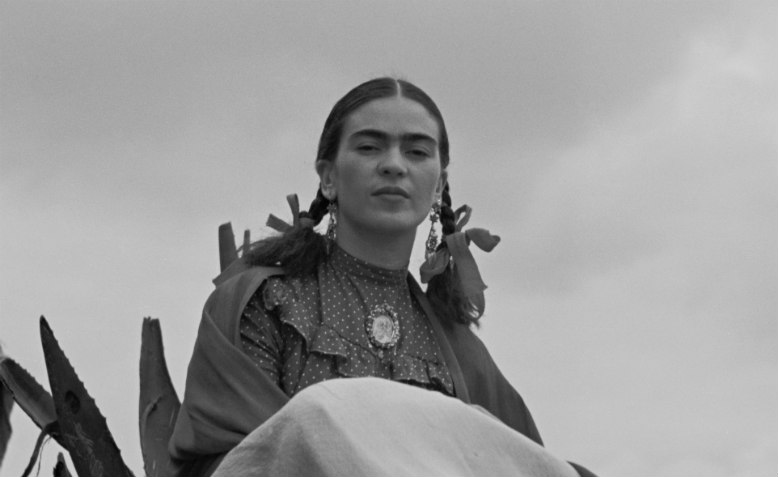 Frida Kahlo, Vogue photoshoot, 1937. Photo: Wikimedia Commons
Frida Kahlo, Vogue photoshoot, 1937. Photo: Wikimedia Commons
Frida Kahlo was a revolutionary and a politically-committed artist whose art condemned the society she revolted against argues Judy Cox
Frida Kahlo is one of the most iconic and contradictory cultural figures around: a card-carrying Communist whose image adorned a bracelet worn by Theresa May, a feminist who has her own barbie doll. Her mega-star status has been confirmed by the sell-out exhibition currently at the V&A Museum, ‘Frida Kahlo: Making Herself Up’. The exhibition features some 200 of her personal artefacts discovered when a sealed room in her house was opened in 2004. It includes photos, decorative Mexican dresses and shawls, and surgical braces, crutches and casts. Some of these items are intensely personal, including her prosthetic leg which is still wearing a beautiful red leather boot. Childhood polio and a terrible accident left her an enduring legacy of pain and disability. This combination of style and suffering combined with her ability to define her own image, generates devotion among Kahlo’s legions of fans.
However, Frida Kahlo’s life was about more than style and suffering – she was an artist and a revolutionary. She transformed her suffering into blazing, intense paintings. Guardian art critic Jonathon Jones described how her paintings are alive and intimate in a way that old clothes and pill bottles featured in the exhibition can never be, and how these ‘relics’ suggest that her transformation into a populist saint now overshadows her artistic brilliance.

This overshadowing is nothing new. For decades, Kahlo was dismissed by art critics as a painter of crude, simplistic self-portraits. She was eclipsed by her hugely successful husband, Diego Riviera, painter of subversive murals, who shared her revolutionary politics and unconventional lifestyle. In the 1980s, feminists such as Madonna rediscovered Kahlo’s paintings, her creative ability to express her personal experiences and to reinvent herself. However, Kahlo’s ambition as an artist went far beyond her own image and biography. Kahlo painted her exterior, her face, her body, her clothes, to express an inner reality: she was a magical realist and a surrealist who explored the hidden parts of human consciousness. Artist Andre Breton described her art as, ‘a ribbon around a bombshell’. Her art condemned the society she revolted against and that revolt was more central to her life and art than was makeup and jewellery.
While thousands have Frida devotees head for the V&A this summer, an exhibition of Kahlo’s work in Budapest has drawn criticism for ‘promoting communism’. In July, a right-wing pro-government newspaper declared, ‘You won’t believe it, but Trotsky has emerged in Budapest again, this time from Frida Kahlo’s bed’. Kahlo’s fascination with Mexican clothes was just one element of her deep commitment to the ideals of the Mexican revolution of 1910, the forging of a national identity in contrast to the domination of the US. She claimed to be a ‘daughter of the revolution’. She was dedicated to the indigenismo, a cultural and political movement which aimed to purge Mexico from colonisation.
Frida Kahlo was one of the first women to be admitted to the National Preparatory School in Mexico City. During the 1920s, she mixed with communists and feminists in the café society and met her future husband, the Communist Diego Rivera. She defied conventions to enjoy passionate relationships with men and women. Rivera brokered a deal with the Mexican president which allowed Leon Trotsky and his wife Natalia to spend their time in exile in Mexico. During their stay, Kahlo had an affair with Trotsky. She later switched allegiance to Stalin, remaining a card-carrying member of the Communist Party for 25 years of her life.
Some critics have argued that while Riviera was a political artist who depicted the broad sweep of Mexican history and included Marx and Lenin in his murals, Kahlo focused on personal experiences, miscarriage and childbirth, blood and fertility. This is to misunderstand the political dimensions of Kahlo’s artistic defiance against gendered conventions and oppression of women’s bodies and minds.
Frida Kahlo is a supreme example of the processes by which capitalist society offers the possibility of artistic freedom on one hand and snatches it back with the other. Karl Marx argued that artists could not escape from the general conversion of all human creativity into commodities:
The bourgeoisie has stripped of its halo every occupation hitherto honoured and looked up to with reverent awe. It has converted the physician, the lawyers, the priest, the poet, the man of science, into its paid wage labourers.
Radical and challenging cultural developments are rapidly incorporated into the system as commodities. Yet, even stripped of its halo, art remains capable of diagnosing and pointing beyond alienating social and economic conditions. Frida Kahlo stands in a great tradition of politically-committed artists who have changed the way we see the world.

